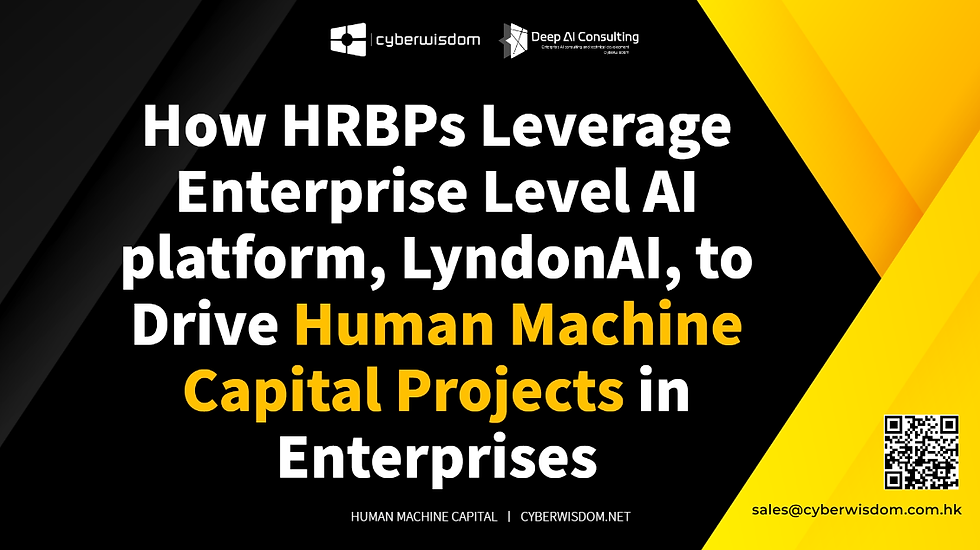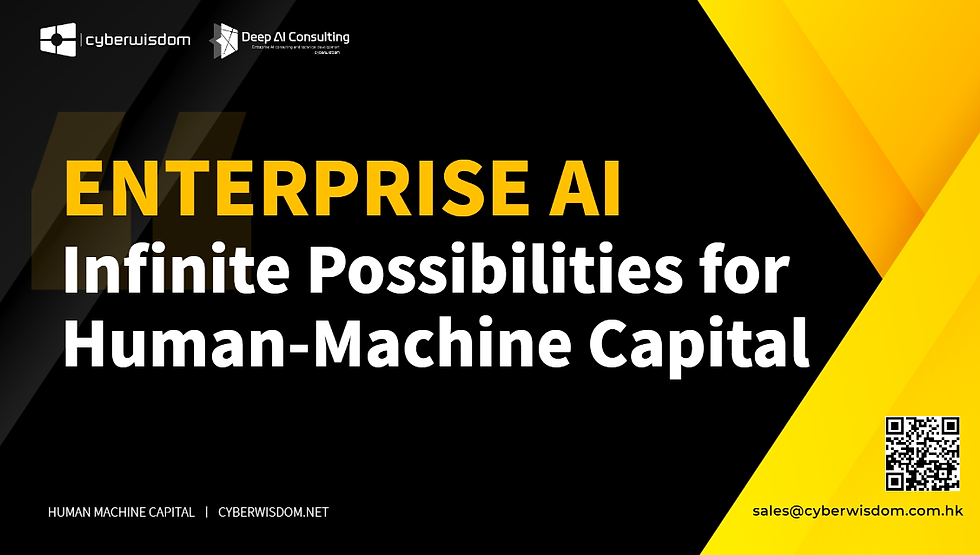How HRBPs Leverage Enterprise Level AI platform, LyndonAI, to Drive Human Machine Capital Projects in Enterprises
- Cyberwisdom Enterprise AI Team-Cherry

- Aug 11
- 6 min read
Updated: Sep 1

In the era of Human Machine Capital (HMC), HR Business Partners (HRBPs) serve as the critical link connecting senior management, business departments, and IT teams. Their core mission is to translate "human-machine collaboration" from a strategic concept into organizational practice. LyndonAI, as an enterprise-level intelligent ecosystem platform under Cyberwisdom Group, provides HRBPs with end-to-end tool support covering "collaborative communication, process automation, knowledge precipitation, and risk governance," enabling them to efficiently advance HMC projects within complex organizations. Below is an analysis of HRBPs' practical pathways across four core scenarios:
I. Aligning Strategic Consensus: Breaking Cognitive Barriers in "Human-Machine Collaboration" with VibeChat
Senior managers, business leaders, and frontline employees often have fragmented understandings of "Human Machine Capital": management focuses on strategic value, business departments worry about practical efficiency, and employees fear technological displacement. HRBPs must first eliminate these cognitive gaps through a unified communication platform, and VibeChat serves as the core carrier for this process.
For Executives: Translating Strategy into "Perceivable Scenarios"
HRBPs can utilize VibeChat's "AI Meeting Assistant" to real-time extract key goals of "human-machine collaboration" (e.g., "Reduce administrative costs by 30% through AI robots" or "Enable 80% of frontline employees to master intelligent tools") during senior strategic meetings. The system automatically generates a correlation map linking "strategy, business, and human-machine collaboration." For example, when the CEO proposes "improving customer response speed," VibeChat can link business data to suggest, "Classify customer inquiries automatically via Optima robots, with sales associates handling complex needs manually"—transforming abstract strategy into actionable human-machine division of labor.
For Business Departments: Replacing "Preaching" with a "Case Library"
To address business leaders' resistance rooted in fears of hassle and risk, HRBPs can build a "Human-Machine Collaboration Case Library" in VibeChat, featuring successful practices from industry peers or internal pilots (e.g., "A store used Optima robots to automatically count foot traffic, allowing sales associates to focus on customer service, increasing conversion rates by 15%"). Through natural language interaction, business leaders can query "AI tools reusable in their departments" and "human resource adjustment plans post-implementation" at any time. VibeChat, leveraging knowledge from Kora, automatically generates tailored recommendations, lowering decision-making barriers.
For Frontline Employees: Alleviating Tech Anxiety with "Conversational Learning"
Resistance to AI among frontline employees often stems from "not knowing where to start." HRBPs can use VibeChat's "intelligent Q&A" function to transform complex technical manuals into "scenario-based dialogues" (e.g., if an employee asks, "How can AI help with attendance tracking?" the system pushes Optima robot operation videos and local case studies). Critically, VibeChat allows employees to real-time feedback "tool usage pain points," which HRBPs can aggregate to collaborate with IT teams on tool optimization—forming a closed loop of "feedback, iteration, and re-promotion."
II. Activating Human-Machine Collaboration: Unleashing Grassroots "Innovation Sparks" via Optima and Kora
A key task for HRBPs is to identify employees with AI potential at the grassroots level (e.g., the "three micro-talents" mentioned earlier) and help them evolve from "tool users" to "designers of human-machine collaboration." LyndonAI's Optima (AI robot system) and Kora (knowledge management system) form the dual-engine for "innovation empowerment."
Lowering Innovation Barriers with Optima: Empowering Grassroots Employees to "Dare to Build AI"
Given the limited technical background of frontline employees, HRBPs can collaborate with IT teams to build a "no-code robot template library" based on Optima, covering high-frequency scenarios such as attendance tracking, inventory alerts, and customer tagging. For example:
Sales associates can upload 3 months of sales data to Optima, label "bestseller features," and the system automatically generates a "hot product prediction tool";
Cashiers can quickly configure a "member points automatic reminder robot" by dragging templates, with no coding required.
HRBPs track usage data of these "grassroots tools" (e.g., reuse frequency, efficiency gains), reward standout employees with "innovation points" (redeemable for training resources), and promote their cases via VibeChat to inspire broader participation.
Precipitating "Collaborative Experience" with Kora: Translating Individual Innovation into Organizational Capability
Tools developed by grassroots employees are often fragmented and hard to reuse. HRBPs leverage Kora's "knowledge structuring" function to transform these innovations into standardized assets:
Guide employees to document tool "design logic" in Kora (e.g., "Inventory alert robots trigger when 'sales volume < 30% and expiration date < 7 days'"), forming a "human-machine collaboration rule library";
Leverage Kora's "context association" feature to seamlessly connect tools with business processes (e.g., "Return processing workflows" automatically linked to "return reason classification robots"), helping new employees quickly locate and utilize relevant tools.
Through this approach, an HRBP at a retail enterprise precipitated 47 grassroots innovation tools within 6 months, and Kora integration increased cross-store reuse rates from 12% to 68%.
III. Breaking Data Silos: Fusion Enables HRBPs to Visualize "Human-Machine Effectiveness"
Traditional HRBPs often struggle to evaluate HMC project outcomes due to "data scattered across CRM, ERP, and HR systems." LyndonAI's Fusion (intelligent search system) integrates full data, providing HRBPs with clear visibility into the real value of "human-machine collaboration."
Building a "Human-Machine Effectiveness Dashboard" to Demonstrate Value to Management
HRBPs can integrate Optima's robot operation data, Kora's knowledge reuse data, and business system performance metrics via Fusion to generate multi-dimensional reports:
Efficiency: e.g., "AI robots handle 60% of attendance calculations, freeing 40% of HR specialists' time";
Innovation: e.g., "12 tools developed by grassroots employees save 2,300 working hours cumulatively";
Risk: e.g., "TRISM module detected biases in 3 robots, with rules updated via Kora."
These insights are real-time shared with executives via VibeChat, serving as a basis for resource allocation decisions.
Identifying "Human-Machine Collaboration Breakpoints" to Refine Management Strategies
Fusion's "correlation analysis" helps HRBPs uncover hidden issues: for instance, if adoption of an "AI customer tagging tool" is low at a store, the system may reveal root causes like "tool incompatibility with elderly customer characteristics" or "lack of targeted employee training." HRBPs can then collaborate with business departments to adjust tool design and deploy "customized training robots" via Optima to improve adoption.
IV. Managing Risk and Compliance: TRISM and Governance Modules Build "Human-Machine Trust"
Advancing HMC projects relies on employee trust in AI, rooted in "transparency, controllability, and compliance." LyndonAI's TRISM framework and enterprise AI lifecycle governance module provide HRBPs with systematic risk management tools.
Eliminating "Algorithm Black Boxes" with TRISM: Enabling Employees to "Trust AI"
HRBPs collaborate with legal and IT teams to leverage TRISM for:
Algorithm transparency: Publishing AI tool "decision logic" in Kora (e.g., "Performance evaluation robots use weights: 60% performance, 30% collaboration, 10% innovation");
Bias detection: TRISM automatically scans historical decisions of Optima robots (e.g., in recruitment screening) and alerts HRBPs to gender or age biases, prompting rule adjustments;
Privacy protection: Setting data access permissions (e.g., "Salary robots visible only to HRBPs and employees themselves") and educating employees on data security via VibeChat.
Ensuring Project Sustainability with Lifecycle Governance
To avoid "AI tools being idle post-launch," HRBPs establish "end-to-end management mechanisms" via governance modules:
Development Phase: Mandating all AI tools to document "applicable scenarios, anticipated outcomes, and accountable individuals" in Kora for record-keeping.
Operation phase: Optima generating regular "tool health reports" (e.g., usage rate, error rate), with HRBPs initiating "optimization or retirement" processes for underperforming tools;
Iteration phase: Driving tool upgrades (e.g., adding "dialect recognition" to customer service robots) based on Fusion's data analysis.

Conclusion: HRBPs as "Weavers of the Human Machine Capital Ecosystem"
Supported by LyndonAI, HRBPs evolve from "executors" to "ecosystem weavers": weaving a "consensus network" via VibeChat, an "innovation network" with Optima and Kora, a "data network" through Fusion, and a "trust network" using TRISM and governance modules. At its core, this network is not about technology but "enabling every employee to create value in human-machine collaboration"—aligning with Cyberwisdom Group's vision of "human-machine symbiosis." The ultimate goal of HRBPs is to leverage technological empowerment to create a "1+1>2" organizational synergy between human creativity and machine efficiency, the core competitiveness of the Human Machine Capital era.
About Cyberwisdom Group
Cyberwisdom Group is a global leader in Enterprise Artificial Intelligence, Digital Learning Solutions, and Continuing Professional Development (CPD) management, supported by a team of over 300 professionals worldwide. Our integrated ecosystem of platforms, content, technologies, and methodologies delivers cutting-edge solutions, including:
wizBank: An award-winning Learning Management System (LMS)
LyndonAI: Enterprise Knowledge and AI-driven management platform
Bespoke e-Learning Courseware: Tailored digital learning experiences
Digital Workforce Solutions: Business process outsourcing and optimization
Origin Big Data: Enterprise Data engineering
Trusted by over 1,000 enterprise clients and CPD authorities globally, our solutions empower more than 10 million users with intelligent learning and knowledge management.
In 2022, Cyberwisdom expanded its capabilities with the establishment of Deep Enterprise AI Application Designand strategic investment in Origin Big Data Corporation, strengthening our data engineering and AI development expertise. Our AI consulting team helps organizations harness the power of analytics, automation, and artificial intelligence to unlock actionable insights, streamline processes, and redefine business workflows.
We partner with enterprises to demystify AI, assess risks and opportunities, and develop scalable strategies that integrate intelligent automation—transforming operations and driving innovation in the digital age.
Vision of Cyberwisdom
"Infinite Possibilities for Human-Machine Capital"
We are committed to advancing Corporate AI, Human & AI Development



Comments